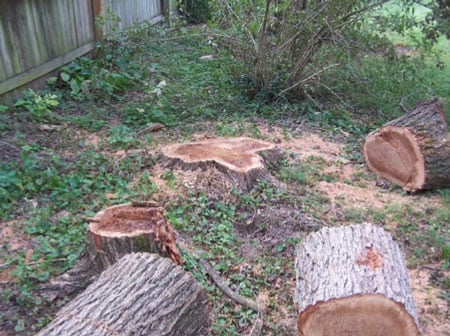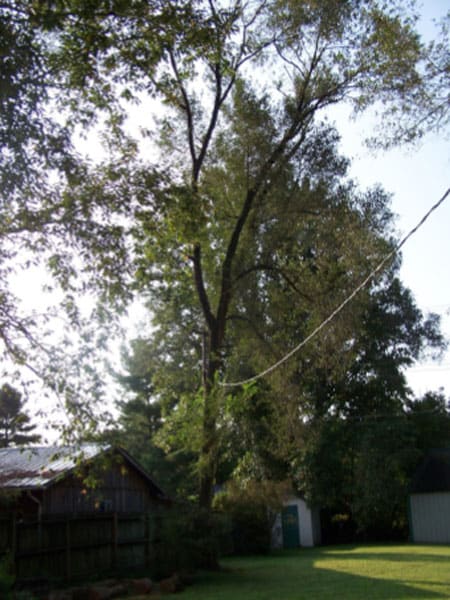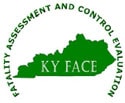Arborist Dies After Fall from Tree
Kentucky Case Report: 09KY059
Report Release Date: February 19, 2010
Summary
A 30-year old arborist was hired by a private resident to remove trees from a yard. At approximately 5:00 PM, the arborist, along with a ground person, arrived at the residence. The arborist donned climbing spurs, and a tree climbing saddle then spoke briefly with the homeowner. With the climbing line and spurs, the arborist climbed the first tree. After trimming limbs from the tree trunk, the arborist began cutting the tree trunk one section at a time. There was a power line near the trees. The arborist was working at the fork of the tree and had cut a section of tree trunk which he had secured with a pull rope. The arborist then signaled his ground person that the section was free to be lowered to the ground. Unbeknownst to the arborist, his safety rope was connected to the tree trunk section to be lowered and he fell to the ground with the tree trunk section. His ground person immediately administered first aid. The homeowner heard the commotion, went outside, and discovered the arborist on the ground with his ground person administering first aid. Emergency medical services were contacted immediately. Upon EMS arrival, they found the arborist without vital signs and contacted the local coroner who arrived and declared the arborist dead at the scene.
To prevent future occurrences of similar incidents, the following recommendations have been made:
- Recommendation No. 1: Tree removal companies should have an applicable written safety program based upon American National Standards Institute ANSI Z133.1-2006 and other applicable standards and regulations.
- Recommendation No. 2: Appropriate personal protective equipment should be worn while removing trees.
- Recommendation No. 3: Tree removal should be performed when workers are alert.
- Recommendation No. 4: Arborists should be professionally certified in tree removal.
- Recommendation No. 5: The Occupational Safety and Health Administration should include specific standards for arborists in the Code of Federal Regulations 1910 General Industry.
Background
The decedent worked a full-time job (not tree removal), and owned and operated a tree removal company on a part-time basis. He was the only employee of the company and used temporary help when required. Prior to starting his own tree removal service, the arborist had been employed by another professional tree removal service company which had trained him on tree removal procedures and safety techniques. It is unknown if the arborist was a Certified Treecare Safety Professional (CTSP).
On the day of the incident, there was a 0.02” of precipitation and the temperature ranged from 60 degrees Fahrenheit to 81 degrees Fahrenheit. Sunset occurred at 7:55 PM.
Investigation
In the fall of 2009, the Kentucky Fatality Assessment and Control Evaluation program was notified via a coroner of an occupational fatality involving an arborist removing trees at a private residence. A site visit was conducted, and photographs were taken. Interviews were held with the homeowner, coroner, and the local police.
A homeowner was concerned that four mature Siberian Elm trees located in the back yard next to a wooden fence on the property line, created a possible hazard to neighboring property. A driveway and garage were located under the tree canopy on the neighbor’s side of the fence. The trees were approximately 50 feet – 60 feet tall and were approximately 70 feet from the homeowner’s house. A residential power line ran from the neighbor’s property through the trees to the homeowner’s house. The ground was flat. To abate the hazard to the neighboring property, and the power line, the homeowner hired a tree removal company to cut down the four trees. The arborist was to remove all limbs, branches, tree trunks, and debris from the property.
On the day of the incident, the arborist finished his eight-hour day at his full-time job and arrived at the residence shortly after 5:00 PM in a pickup truck hauling a wood chipper behind. He had with him one ground person, climbing spurs, a tree climbing saddle, a small chain saw, and three ropes: an orange 12 – 16 strand braided rope used for climbing (climbing line); a blue 12 – 16 strand, braided rope, 7’ – 9’ long, that was used as a safety line (personal lanyard); and a white, three-strand twisted rope that was used for pulling/ lowering tree sections to the ground (work line).
Upon arriving at the work site, the arborist donned his spurs and climbing saddle then met briefly with the homeowner. Three of the four trees to be removed were in a line and close together. Facing the wooden fence and the three trees grouped together, the tree on the left was 14” – 16” in diameter, the middle tree was approximately 18” in diameter, and the diameter of the tree on the right was unknown. There was approximately three feet between the tree on the left and the middle tree, and approximately eight feet from the middle tree to the tree on the right. The arborist used his climbing line to climb the middle tree and secure himself to a fork in the middle tree. The personal lanyard’s length could be adjusted by being pulled in or out through a prussic knot in a short piece of rope tied to a snap or carabiner affixed to a side D-ring on the climbing saddle. The lanyard went around the tree and the other end of the lanyard was affixed to the D-ring on the opposite side of the saddle, allowing the climber to secure himself in position, and the climbing line (when the lanyard was detached from the tree) allowed him to move freely around the canopy of the three trees.
The chain saw was pulled up the tree on the orange climbing line. The arborist then used the chain saw to cut away branches from the three trees. As the limbs fell to the ground, the ground person hauled them to the wood chipper. The arborist had completely removed the canopy from the left and middle trees and some of the canopy from the tree on the right. Sections of the left and middle tree trunks had also been removed and lowered to the ground. The arborist had tied one end of the work line to the tree on the left approximately 16 feet up the trunk, and tied the other end of the same rope to the fork approximately 20 feet high on the middle tree. The arborist had secured his lanyard through a fork where both the work line and lanyard were tied. The arborist signaled his ground person to pull the cut tree trunk section to the ground. The tree trunk section and arborist both fell to the ground.
The homeowner was inside the residence visiting with a neighbor. At approximately 7:10 PM, the neighbor said that something outside did not sound right. The homeowner and neighbor went outside and found the arborist at the base of the tree and the assistant administering medical aid. The climbing rope was found wrapped around the tree trunk and the arborist’s hand and body; the lanyard was wrapped around the tree trunk at the fork, and the work line was wrapped around the fork of the tree trunk as well. The homeowner contacted emergency medical services who arrived and found the arborist without vital signs.
Back to Top
Cause of Death
The death certificate states the cause of death as blunt force trauma to head and fall from tree.
Recommendations/Discussion
Recommendation No. 1: Tree removal companies should have an applicable written safety program based upon American National Standards Institute ANSI Z133.1-2006, American National Standard for Arboricultural Operations – Safety Requirements, and other applicable standards and regulations.
The Occupational Safety and Health Administration Safety and Health tree care topics website page provides guidance on safety program components for tree removal companies. More specific guidance can also be found in the American National Standards Institute ANSI Z133.1-2006, American National Standard for Arboricultural Operations – Safety Requirements. Every tree removal company should have a written safety program that outlines and explains all required personal protective equipment (PPE), how to conduct a hazard assessment at the beginning of each job, and procedures for all tree removal tasks. Ropes were not placed properly around the tree which caused the arborist to fall. Proper rope placement should be included in the written safety program. Procedures on care of tree removal equipment such as ropes should be included in the safety procedures. Ropes should be checked before work commences, and if found unsafe by damage or defect, must be removed from service. Photographs of the scene showed that the ropes used in this incident were frayed.
Recommendation No. 2: Appropriate personal protective equipment should be worn at all times while removing trees.
At the time of this incident, the arborist was wearing spurs and a climbing saddle. A pair of darkened safety glasses were found on the ground next the arborist’s body. The arborist was not wearing a helmet, and his legs were not through the leg straps on the climbing saddle. Occupational Safety and Health Administration standard 1910.135 states that head protection will be worn to protect workers from falling objects. The American National Standard Institute gives guidance on head protection for workers in the following standards: ANSI Z89.1-2003, “American National Standard for Industrial Head Protection.”
Recommendation No. 3: Tree removal should be performed when workers are alert.
The Agriculture, forestry, fishing, hunting industry sector had the highest occupational fatality rate in the United States (BLS, 2006), and tree removal, in particular, had the third highest occupational fatality rate in 2005. It is important for all businesses to have safety protocols in place, even businesses with just one employee, the owner. Safety protocols in hazardous occupations such as tree removal should include recognition of fatigue; how to reduce it, and when to discontinue work because of it. Tree removal is a dangerous task, and should only be performed when workers are alert and well rested. The arborist involved in this incident had worked a full eight hour day prior to beginning the hazardous task of removing the trees. Work had commenced shortly after 5:00 PM indicating the owner had not had time to adequately rest between his full-time job and his part-time job of tree removal. Workers performing hazardous duties such as tree removal should be aware of fatigue and delay work until properly rested.
Recommendation No. 4: Arborists should be professionally certified in tree removal.
Professional arborists should obtain the Certified Treecare Safety Professional (CTSP) certification. Certification consists of the arborist being educated in safety, tree care, and proper business practices. When hiring an arborist, homeowners should consider hiring only certified arborists to perform tree removal from their property. It is unknown if the arborist in this report was a certified treecare safety professional. Homeowners in Kentucky may contact the Kentucky Arborist Association, or the Tree Care Industry Association, to locate a certified arborist.
Recommendation No. 5: The Occupational Safety and Health Administration should include specific standards for arborists in the Code of Federal Regulations 1910 General Industry.
Tree removal is one of the most dangerous jobs performed. In researching safety practices used by arborists for this report, no specific Occupational Safety Administration guidance was found for tree removal. Specific safety regulations should be developed for arborists and should be included in 1910 General Industry standards. The Tree Care Industry Association has formally petitioned federal OSHA to adopt such a standard, and is working with the state of Virginia to develop safety standards for arborists for that state. Perhaps the Virginia standard should be considered as a template for adoption nationwide.
Keywords: Arborist, climbing line, lanyard, tree removal, work line
References
- Office of Federal Register, Occupational Safety and Health Administration 1910.132 – 136 Personal Protective Equipment
- American National Standards Institute ANSI Z133.1-2006, American National Standard for Arboricultural Operations – Safety Requirements
- Occupational Safety and Health Administrationexternal icon, https://www.osha.gov/SLTC/treecare/index.html (Link updated 3/27/2013)
- American National Standards Institute Z89.1-2003, “American National Standard for Industrial Head Protection,”
- American National Standards Institute Z89.1-1997, “American National Standard for Industrial Head Protection,”
- American National Standards Institute Z89.1-1986, “American National Standard for Personnel Protection — Protective Headwear for Industrial Workers—Requirements.”
- Office of the Federal Register. Occupational Safety and Health Administration 29 CFR 1910.266 Logging
- Office of the Federal Register. Occupational Safety and Health Administration CFR 1910.266,
- Code of Federal Regulations. Washington, DC: US Government Printing Offices; 1995.
- Bureau of Labor Statisticspdf iconexternal icon, http://www.bls.gov/iif/oshwc/cfoi/cfch0005.pdf
- Tree Care Industry, August 2006, Lessons Learned from Accident Researchpdf iconexternal icon, http://tcia.org/PDFs/Safety/Lessons_Learned.pdf (Link updated 8/13/2013)
- Safe Work Practices for Certified Utility Arboristspdf iconexternal icon, Workers’ Compensation Board of British Columbia, http://worksafebc.com/publications/health_and_safety/by_topic/assets/pdf/cert_
utility_arborist.pdf - Tree Care Industry Association, Pocket Guidesexternal icon https://secure.tcia.org/core/orders/product.aspx?prodId=476&catId=20 (Link updated 3/27/2013)
- American Pulpwood Association Inc. The Logger’s Guide to the New OSHA Logging Safety Standards (95-A-14). Rockville, MD: Author; 1995.
- NIOSH. Preventing Injuries and Deaths of Loggers (Alert). Cincinnati, OH: Author; 1995. (DHHS [NIOSH] Publication No. 95-101)
- U.S. Department of Labor, Occupational Safety and Health Standardsexternal icon, https://www.osha.gov/pls/oshaweb/owadisp.show_document?p_table=STANDARDS&p
_id=9862&p_text_version=FALSE#1910.266(h)(2) - The Ohio State University Extension, AEX, 192.2.42, Tailgate Safety Training for Landscape and Horticultural Servicespdf iconexternal icon, http://ohioline.osu.edu/aex-fact/192/pdf/0192_2_42.pdf
- Fatigue – do not work in trees when fatigued.
- Injury Prevention 2004;10:239-243 doi:10.1136/ip.2003.004663, D.F. Scott, A Study of Logger Fatalities from 1992 – 2000 http://injuryprevention.bmj.com/content/10/4/239.full
Associations
International Society of Arboricultureexternal icon, http://www.isa-arbor.com/
Kentucky Arborist Associationexternal icon, http://www.kyisatree.org/
Tree Care Industry Associationexternal icon, http://tcia.org/ (Link updated 8/13/2013)
Acknowledgements
KY FACE would like to thank the following people for their assistance with this report:
Arborist association
Homeowner
Local coroner
Local police
Professional arborist
Photographs
 |
|---|
| Photograph of two tree stumps the arborist was removing. Photograph property of KY FACE. |
 |
| Photograph of third tree to be removed and power line. Photograph property of KY FACE. |
Kentucky FACE Program
The Kentucky Fatality Assessment & Control Evaluation Program (FACE) is funded by a grant from the Centers for Disease Control and the National Institute of Safety and Health. The purpose of FACE is to aid in the research and prevention of occupational fatalities by evaluating events leading to, during, and after a work related fatality. Recommendations are made to help employers and employees to have a safer work environment. For more information about FACE and KIPRCexternal icon, please visit our website at: www.mc.uky.edu/kiprc/ (Link updated 3/27/2013)
To contact Kentucky State FACE program personnel regarding State-based FACE reports, please use information listed on the Contact Sheet on the NIOSH FACE web site. Please contact In-house FACE program personnel regarding In-house FACE reports and to gain assistance when State-FACE program personnel cannot be reached.

